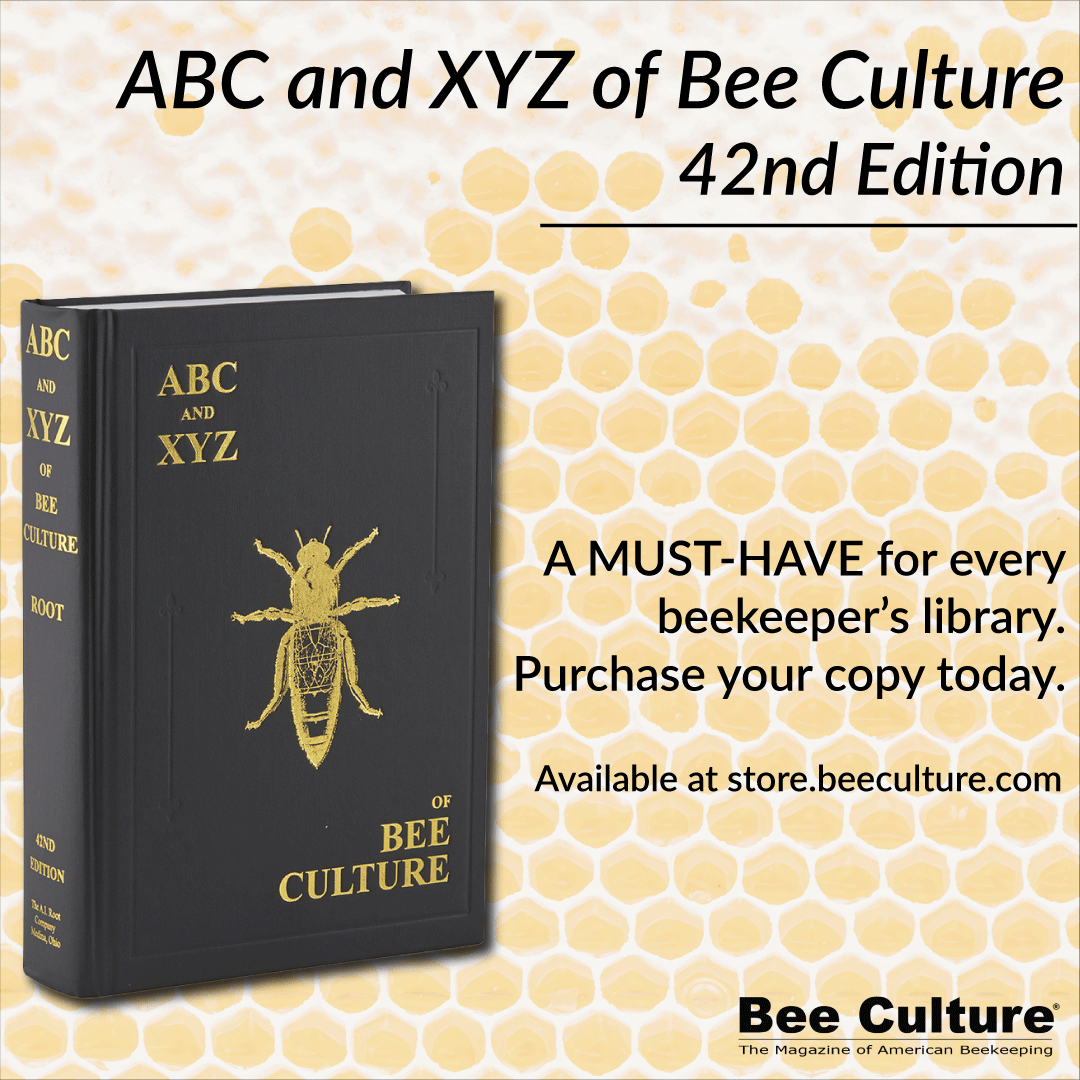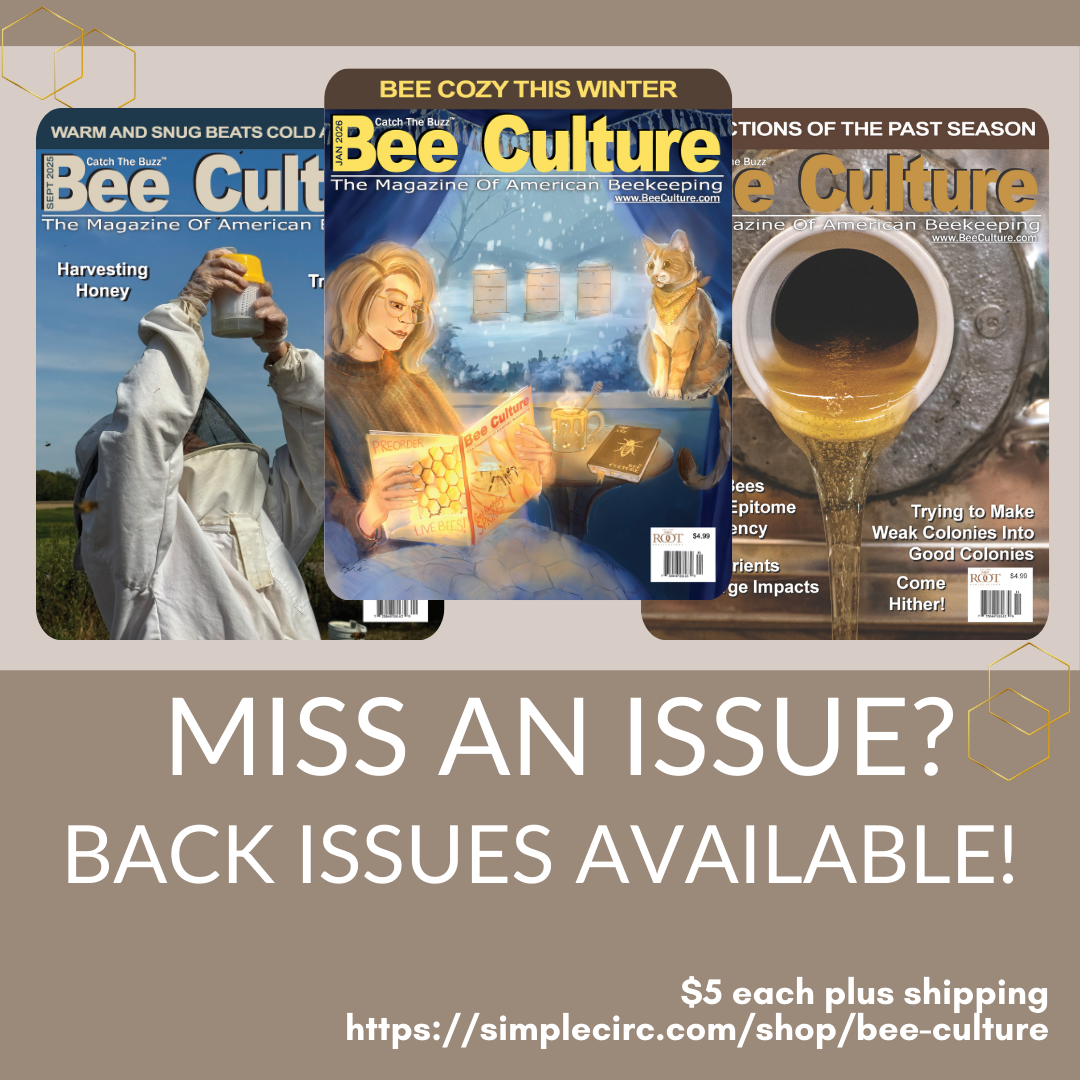Sperm Viability
by- Clarence Collison
The survival of a honey bee colony depends, in part, on the reproductive success of the queen, which in turn depends on the viability of sperm produced by drones with which the queen mates.
The health of honey bee queens is closely linked to colony performance as a single queen is normally responsible for all egg laying and brood production within the colony. In the U.S. in recent years, queens have been failing at a high rate; with 50% or greater of queens replaced in colonies within six months when historically a queen might live one to two years or even longer. This high rate of queen failure coincides with the high mortality rates of colonies in the U.S., some years with 50% of colonies dying. Pettis et al. (2016) surveyed sperm viability in U.S. queens to determine if sperm viability plays a role in queen or colony failure. Wide variation was observed in sperm viability from four sets of queens removed from colonies that beekeepers rated as in good health (n=12; average viability = 92%), were being replaced as part of normal management (n=28; 57%), or where rated as failing (n=18 and 19; 54% and 55%). Two additional paired set of queens showed a statistically significant difference in viability between colonies rated by the beekeepers as failing or in good health from the same apiaries. Queens removed from colonies rated in good health averaged high viability (ca. 85%) while those rated as failing or in poor health had significantly lower viability (ca. 50%). Thus low sperm viability was indicative of, or linked to, colony performance.
To further explore the source of low sperm viability, six commercial queen breeders were surveyed and wide variation in viability (range 60-90%) was documented between breeders. This variability could originate from the drones the queens mate with or temperature extremes that queens are exposed to during shipment. The role of shipping temperature as a possible explanation for low sperm viability was investigated. They documented during shipment queens are exposed to temperature spikes (<8 and > 40ºC; 46.4-104ºF) and these spikes can kill 50% or more of the sperm stored in queen spermathecae in live queens. Laboratory studies were conducted to further explore the role of temperature extremes on sperm viability. A set of 60 queens were obtained via United Parcel Service from a single queen breeder and randomly sub-divided and subjected to either 4ºC for one, two, or four hours or 40ºC for one or four hours with control queens held at 30ºC (86ºF). Following temperature exposures, all queens were held an additional six days at 30ºC to allow time for any detrimental effects on sperm to be realized. On day seven all queens were sacrificed and sperm viability measured. The laboratory exposure of queens to extreme temperatures resulted in significant reductions in sperm viability after only one or two hours at either high or low temperatures. Exposures longer than one to two hours at 4ºC or 40ºC did not result in additional increased mortality. Clearly low sperm viability is linked to colony performance and laboratory and field data provide evidence that temperature extremes are a potential causative factor (Pettis et al. 2016).
Tarpy and Olivarez (2014) investigated how sperm viability within a queen’s spermatheca changed over time. Their results show that sperm viability decreases over time while stored in the queen’s spermathecae. This pattern could have several potential explanations, such as differential use of live vs. dead sperm (i.e., as a queen lays fertilized eggs using live sperm, the proportion of dead sperm increases as a function of sperm use) or possibly increased physiological stress of long-term sperm storage that results in sperm mortality.
Another source of low sperm viability within the spermatheca may be associated with the drones that the queen mates with. Czekońska et al. (2013) compared the volume of semen and viability of spermatozoa collected from drones at ages 15, 20, 25, and 30 days. The drones originated from different queens and were reared in different environments. Semen volume was determined by measuring the filled length of a capillary. Percentages of live and dead spermatozoa were determined by SYBR-14/propidium iodine fluorescence staining and flow cytometry. The volume of semen collected from drones ranged from 0.5 to 1.3 µL. The mean volume of semen significantly decreased with drone age. Sperm viability increased significantly with drone age.
The survival of a honey bee colony depends, in part, on the reproductive success of the queen, which in turn depends on the viability of sperm produced by drones with which the queen mates. Colony success also depends on management of the ectoparasitic bee mite, Varroa destructor, which has historically been achieved using miticides that may also impact honey bee health. Previous work has demonstrated that the exposure of drone honey bees to miticidal Checkmite+TM strips (coumaphos) can result in decreased sperm viability. Johnson et al. (2013) applied a range of sublethal doses of six miticides (tau-fluvalinate, coumaphos, fenpyroximate, amitraz, thymol and oxalic acid) to one to four day old adult drones. The drones were returned to their home colony and re-collected two to three weeks later to assess sperm viability using SYBR14 and propidium iodide stains. Counts of live and dead sperm were automated using the EBImage library in the R statistical environment. Sperm viability was not affected by any of the six miticide treatments, which suggests that acute miticide exposure in adult drones has little effect on drones’ reproductive potential. However, two of the six miticides tested had an effect on drone recapture rate: fenpyroximate reduced and thymol increased the likelihood of drone recapture. These results suggest that future research on the effect of pesticides to drone sperm viability should focus on exposure in the immature stages and that beekeepers concerned with drone reproductive health may be able to safely apply miticides when only adult drones are present.
Numerous factors appear to cause the honey bee population declines that have been experienced in recent years; parasites, pathogens, malnutrition and pesticides. Residues of the organophosphate acaricide coumaphos, and the neonicotinoid insecticide imidacloprid, widely used to combat Varroa mites and for crop protection in agriculture, respectively, have been detected in wax, pollen and comb samples. Chaimanee et al. (2016) assessed the effects of these compounds at different doses on the viability of sperm stored in the queen’s spermatheca. Their results demonstrated that sub-lethal doses of imidacloprid (0.02 ppm) decreased sperm viability by 50%, seven days after treatment. Sperm viability was a downward trend (about 33%) in queens treated with high doses of coumaphos (100 ppm), but there was not a significant difference. The expression of genes that are involved in development, immune responses and detoxification in queens and workers exposed to chemicals was measured by qPCR analysis. The data showed that expression levels of specific genes were triggered one day after treatment. The expression levels of P450 subfamily genes, CYP306A1, CYP4G11 and CYP6AS14 were decreased in honey bee queens treated with low doses of coumaphos (5 ppm) and imidacloprid (0.02 ppm). Moreover, these two compounds suppressed the expression of genes related to antioxidation, immunity and development in queens at day one. Up-regulation of antioxidants by these compounds in worker bees was observed at day 1. Coumaphos also caused a repression of CYP306A1 and CYP4G11 in workers. Antioxidants appear to prevent chemical damage to the honey bee. They also found that deformed wing virus (DWV) replication increased in workers treated with imidacloprid. This research clearly demonstrated that chemical exposure can affect sperm viability in queen honey bees.
Burley et al. (2008) examined the potential impacts of coumaphos, fluvalinate and Apilife VAR (Thymol) on drone honey bee sperm viability over time. Drones were reared in colonies that had been treated with each miticide by using the dose recommended on the label. Drones from each miticide treatment were collected and semen samples were pooled. The pooled samples from each treatment were subdivided and analyzed for periods of up to 6 weeks. Random samples were taken from each treatment (n= 6 pools) over the six-week period. Sperm viability was measured using dual-fluorescent staining techniques. The exposure of drones to coumaphos during development and sexual maturation significantly reduced sperm viability for all six weeks. Sperm viability significantly decreased from the initial sample to week one in control colonies, and a significant decrease in sperm viability was observed from week five to week six in all treatments and control. Coumaphos not only decreases the viability of sperm produced by drones exposed to it, but it has also been shown to cause lethal and sublethal effects to queens, including lowered mean number of spermatozoa contained in the spermatheca of queens after mating (Haarmann et al. 2002). Decreasing amounts of sperm entering the spermatheca of coumaphos exposed queens along with lowered sperm viability of exposed drones could lead to queen failure.
For several years, Varroa mites were controlled primarily with two in-hive miticides: the pyrethroid tau-fluvalinate (Apistan) and the organophosphate coumaphos (Checkmite+). Various studies have revealed that the exposure of honey bee colonies to sublethal levels of these chemicals can lead to colony wide health problems. Rangel and Tarpy (2015) looked at the combined effects of fluvalinate and coumaphos on the reproductive health of honey bee queens. They did so by raising queens in either miticide-free beeswax or beeswax containing known concentrations of both coumaphos and fluvalinate. Upon their emergence and successful mating, they took several standard measures of queen’s reproductive health. They found that queens reared in miticide-laden beeswax were not significantly smaller in size, but the spermatheca analysis showed significantly lower sperm counts and viability, and higher mating frequency, compared to queens reared in miticide-free beeswax. Their results indicated that exposure to miticides during development severely compromises queen’s reproductive health. Their findings also demonstrated the importance of the potentially detrimental combined effects of common in-hive miticides on colony health.
Many other factors may ultimately affect the fertility of the drones. Peng et al. (2015) found that all drones fed with Nosema apis spores consequently developed an infection, which they were able to confirm by the presence of morphological changes that became visible in the midgut of infected compared to non-infected drones. They found that the midguts of newly hatched, non-infected drones appeared transparent and remained translucent as drones matured. In contrast, as the infected drones matured, their midgets developed substantial swelling, lost their transparency and changed their color to a grey-white. Microscopic inspections confirmed that the epithelial cells of the midgets of infected drones were filled with N. apis spores and they could observe large numbers of newly-released spores from burst cells. When they compared dissected accessory glands and accessory testes of infected and non-infected drones, they did not find any of the morphological signs of infection as was described for the midgut tissue. They did not find any N. apis spores to be present in the sexual organs of infected drones of any age, neither within the tissue nor in the lumen containing either sperm or seminal fluid. This observation was confirmed histologically when comparing the sexual tracts of non-infected and infected drones of different ages. The muscular tissue surrounding the accessory gland and its epithelial cell layer gradually degenerated with increasing drone age, which was not the case for the muscular tissue surrounding the accessory testes. Peng et al. (2015) was able to show that Nosema apis is able to infect drones and that these infections built up to a point where they induced significant costs for males. They found a reduction in fertility and life span as drones aged, as well as ejaculate of infected drones became contaminated with Nosema spores.
Disease may also affect the reproductive health and longevity of queens. Pettis et al. (2016) in their survey of commercially produced queens checked for three pathogens: Deformed Wing Virus (DVW), Nosema ceranae, and Black Queen Cell Virus (BQCV). All three pathogens were present in queen stocks from each breeder with the exception of BQCV being absent from the queens from breeder five. In general, queens had high prevalence of DWV followed by Nosema ceranae and low prevalence of BQCV.
Queen honey bees artificially inseminated using semen with 46% or more live spermatozoa consistently laid all fertilized eggs in normal worker brood patterns at three to four weeks after insemination. However, queen producers that might use stored semen to preserve breeder stock would want to rear daughter queens throughout a season, longer than these experimental queens were observed. To determine how long queens inseminated with low viability semen continue to produce worker brood, sister queens were inseminated with various mixtures of fresh and freeze-killed semen, or were allowed to mate naturally. Colonies were evaluated for area of comb with all stages of brood, the percentage of worker vs. drone offspring in sealed brood, and the number of empty cells in a representative area of sealed brood once a month for five to six months, at midwinter, and again the following Spring. One queen of 22 queens inseminated with 75% or more fresh semen became a partial drone layer by mid Winter, only two of the 21 queens inseminated with half fresh semen ran out of sperm, but three of five of queens with 25% fresh semen were laying some proportion of unfertilized eggs. Preserved semen that has 50% or better viable sperm can be used to inseminate queens that will function as well as a fully mated queen for at least one season, such that a breeder could rear many daughter queens and incorporate desirable genotypes into a breeding program (Collins 2004).
References
Burley, L.M., R.D. Fell and R.G. Saacke 2008. Survival of honey bee (Hymenoptera: Apidae) spermatozoa incubated at room temperature from drones exposed to miticides. J. Econ. Entomol. 101: 1081-1087.
Chaimanee, V., J.D. Evans, Y. Chen, C. Jackson and J.S. Pettis 2016. Sperm viability and gene expression in honey bee queens (Apis mellifera) following exposure to the neonicotinoid insecticide imidacloprid and the organophosphate acaricide coumaphos. J. Insect Physiol. 89: 1-8.
Collins, A.M. 2004. Functional longevity of honey bee Apis mellifera queens inseminated with low viability semen. J. Apic. Res. 43: 167-171.
Czekońska, K., B. Chuda-Mickiewicz, P. Chorbiński 2013. The influence of honey bee (Apis mellifera) drone age on volume of semen and viability of spermatozoa. J. Apic. Sci. 57: 61-65.
Haarmann, T., M. Spivak, D. Weaver, B. Weaver and T. Glenn 2002. Effects of fluvalinate and coumaphos on queen honey bees (Hymenoptera: Apidae) in two commercial queen rearing operations. J. Econ. Entomol. 95: 28-35.
Johnson, R.M., L. Dahlgren, B.D. Siegfried and M.D. Ellis 2013. Effect of in-hive miticides on drone honey bee survival and sperm viability. J. Apic. Res. 52: 88-95.
Peng,Y., B. Baer-Imhoff, A.H. Millar and B. Baer 2015. Consequences of Nosema apis infection for male honey bees and their fertility. Sci. Rep. 5, 10565; doi: 10.1038/srep10565.
Pettis, J.S., N. Rice, K. Joselow, D. vanEngelsdorp and V. Chaimanee 2016. Colony failure linked to low sperm viability in honey bee (Apis mellifera) queens and an exploration of potential causative factors. PLoS ONE 11(2): e0147220. doi:10.1371/journal.pone.0147220
Rangel, J. and D.R. Tarpy 2015. The combined effects of miticides on the mating health of honey bee (Apis mellifera L.) queens. J. Apic. Res. 54: 275-283.
Tarpy, D.R. and R. Olivarez, Jr. 2014. Measuring sperm viability over time in honey bee queens to determine patterns in stored-sperm and queen longevity. J. Apic. Res. 53: 493-495.









